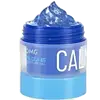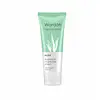What's inside
What's inside
 Key Ingredients
Key Ingredients

 Benefits
Benefits

 Concerns
Concerns

 Ingredients Side-by-side
Ingredients Side-by-side

Water
Skin ConditioningNiacinamide
SmoothingPropanediol
SolventPropylene Glycol
HumectantCentella Asiatica Leaf Extract
Skin ConditioningCarbomer
Emulsion StabilisingAminomethyl Propanol
Buffering1,2-Hexanediol
Skin ConditioningAllantoin
Skin ConditioningZinc Gluconate
Skin ConditioningChlorphenesin
AntimicrobialCaprylhydroxamic Acid
Disodium EDTA
Hydrolyzed Hyaluronic Acid
HumectantBiosaccharide Gum-2
Skin ConditioningPhenoxyethanol
PreservativePentylene Glycol
Skin ConditioningGlycerin
HumectantPanthenol
Skin ConditioningPolysorbate 60
EmulsifyingMadecassoside
AntioxidantPotassium Sorbate
PreservativeSodium Benzoate
MaskingWater, Niacinamide, Propanediol, Propylene Glycol, Centella Asiatica Leaf Extract, Carbomer, Aminomethyl Propanol, 1,2-Hexanediol, Allantoin, Zinc Gluconate, Chlorphenesin, Caprylhydroxamic Acid, Disodium EDTA, Hydrolyzed Hyaluronic Acid, Biosaccharide Gum-2, Phenoxyethanol, Pentylene Glycol, Glycerin, Panthenol, Polysorbate 60, Madecassoside, Potassium Sorbate, Sodium Benzoate
Water
Skin ConditioningCetearyl Alcohol
EmollientDimethicone
EmollientGlycerin
HumectantIsopropyl Myristate
EmollientGlyceryl Stearate
EmollientCeteareth-33
CleansingPhenoxyethanol
PreservativePEG-100 Stearate
Propylene Glycol
HumectantTitanium Dioxide
Cosmetic ColorantAloe Barbadensis Leaf Extract
EmollientParfum
MaskingPEG-20 Stearate
EmulsifyingOlive Oil PEG-7 Esters
EmollientEthylhexylglycerin
Skin ConditioningSodium Benzoate
MaskingPotassium Sorbate
PreservativeWater, Cetearyl Alcohol, Dimethicone, Glycerin, Isopropyl Myristate, Glyceryl Stearate, Ceteareth-33, Phenoxyethanol, PEG-100 Stearate, Propylene Glycol, Titanium Dioxide, Aloe Barbadensis Leaf Extract, Parfum, PEG-20 Stearate, Olive Oil PEG-7 Esters, Ethylhexylglycerin, Sodium Benzoate, Potassium Sorbate
Ingredients Explained
These ingredients are found in both products.
Ingredients higher up in an ingredient list are typically present in a larger amount.
Glycerin is already naturally found in your skin. It helps moisturize and protect your skin.
A study from 2016 found glycerin to be more effective as a humectant than AHAs and hyaluronic acid.
As a humectant, it helps the skin stay hydrated by pulling moisture to your skin. The low molecular weight of glycerin allows it to pull moisture into the deeper layers of your skin.
Hydrated skin improves your skin barrier; Your skin barrier helps protect against irritants and bacteria.
Glycerin has also been found to have antimicrobial and antiviral properties. Due to these properties, glycerin is often used in wound and burn treatments.
In cosmetics, glycerin is usually derived from plants such as soybean or palm. However, it can also be sourced from animals, such as tallow or animal fat.
This ingredient is organic, colorless, odorless, and non-toxic.
Glycerin is the name for this ingredient in American English. British English uses Glycerol/Glycerine.
Learn more about GlycerinPhenoxyethanol is a preservative that has germicide, antimicrobial, and aromatic properties. Studies show that phenoxyethanol can prevent microbial growth. By itself, it has a scent that is similar to that of a rose.
It's often used in formulations along with Caprylyl Glycol to preserve the shelf life of products.
Potassium Sorbate is a preservative used to prevent yeast and mold in products. It is commonly found in both cosmetic and food products.
This ingredient comes from potassium salt derived from sorbic acid. Sorbic acid is a natural antibiotic and effective against fungus.
Both potassium sorbate and sorbic acid can be found in baked goods, cheeses, dried meats, dried fruit, ice cream, pickles, wine, yogurt, and more.
You'll often find this ingredient used with other preservatives.
Learn more about Potassium SorbatePropylene Glycol is an odorless, colorless liquid. As a humectant, it helps skin retain moisture. It also aids in delivering active ingredients.
Another role of this ingredient is preventing a product from melting or freezing. Propylene glycol also adds antimicrobrial properties to a product, elongating product lifespan.
This ingredient is considered an organic alcohol and commonly added into both cosmetics and foods.
Those with sensitive skin or conditions may develop a rash when using this ingredient.
Learn more about Propylene GlycolSodium Benzoate is a preservative. It's used in both cosmetic and food products to inhibit the growth of mold and bacteria. It is typically produced synthetically.
Both the US FDA and EU Health Committee have approved the use of sodium benzoate. In the US, levels of 0.1% (of the total product) are allowed.
Sodium benzoate works as a preservative by inhibiting the growth of bacteria inside of cells. It prevents the cell from fermenting a type of sugar using an enzyme called phosphofructokinase.
It is the salt of benzoic acid. Foods containing sodium benzoate include soda, salad dressings, condiments, fruit juices, wines, and snack foods.
Studies for using ascorbic acid and sodium benzoate in cosmetics are lacking, especially in skincare routines with multiple steps.
We always recommend speaking with a professional, such as a dermatologist, if you have any concerns.
Learn more about Sodium BenzoateWater. It's the most common cosmetic ingredient of all. You'll usually see it at the top of ingredient lists, meaning that it makes up the largest part of the product.
So why is it so popular? Water most often acts as a solvent - this means that it helps dissolve other ingredients into the formulation.
You'll also recognize water as that liquid we all need to stay alive. If you see this, drink a glass of water. Stay hydrated!
Learn more about Water